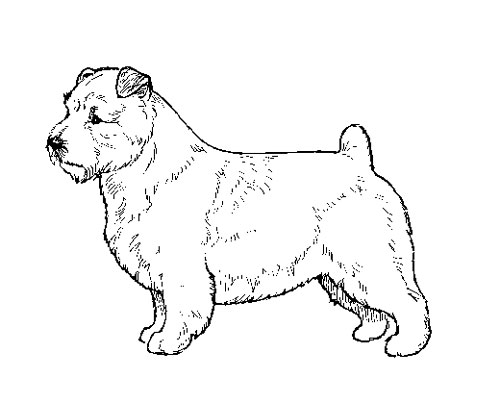Norfolk Terrier
Terrier Group
The goals and purposes of this breed standard include: to furnish guidelines for breeders who wish to maintain the quality of their breed and to improve it; to advance this breed to a state of similarity throughout the world; and to act as a guide for judges.
Breeders and judges have the responsibility to avoid any conditions or exaggerations that are detrimental to the health, welfare, essence and soundness of this breed, and must take the responsibility to see that these are not perpetuated.
Any departure from the following should be considered a fault, and the seriousness with which the fault should be regarded should be in exact proportion to its degree and its effect upon the health and welfare of the dog and on the dog’s ability to perform its traditional work.
History
It is speculated that the Norfolk Terrier was developed using the small Irish Terriers and crossing them with other Terrier breeds, including the Border and Cairn. The breed originally had two varieties, one with drop ears and one with prick ears, which were interbred and shown together. The two varieties were eventually designated as separate breeds, with the prick-eared variety being the Norwich Terrier.
The Norfolk Terrier was recognized by the United Kennel Club in 1979.
General Appearance
One of the smallest of the Terriers, the Norfolk is low to the ground, compact and strong and has good bone and substance. He has a hard, straight coat that does not require excessive trimming. As this is a working breed, honorable scars are not to be penalized in the show ring.
Characteristics
Developed to go to ground to bolt a fox, or to find and dispatch other vermin, the Norfolk is a demon for its size. He is alert and fearless, not aggressive, and has a hardy constitution.
Head
SKULL
Wide between the ears, slightly rounded. There is a well-defined stop.
MUZZLE
Wedge shaped and strong, but not as long as the skull.
TEETH
A full complement of strong, large, white teeth meet in a scissors bite.
EYES
The small, dark, oval-shaped eyes are placed well apart. They have black rims. The eyes have a sparkling, keen, intelligent expression.
EARS
The small, V-shaped ears are slightly rounded at the tip. They are smooth and velvety to the touch. They drop neatly, with a break at the skull line; are carried close to the cheek and do not fall lower than the outer comer of the eye.
Neck
The strong, medium-length neck blends into well laid back shoulders.
Forequarters
Shoulders are well laid back and approximately the same length as the upper arm.
FORELEGS
The legs are short, powerful and straight.
Body
The chest is of good width and is moderately deep. The length of the body, from the point of the withers to the base of the tail, is slightly longer than the height of the dog measured at the withers. The ribs are well sprung. The loins are strong. The topline is level.
Hindquarters
The hindquarters are strong, with broad, muscular thighs.
HIND LEGS
The hind legs are short and powerful with a good turn of stifle and a well let down hock. When viewed from the rear, the rear pasterns are straight.
Feet
The feet are round, with thick pads and strong, black nails.
Tail
The tail is customarily docked to a sufficient length to insure a balanced outline. It is straight and set on high, with the base level with the topline.
Serious Fault: Tail curving more or less forward.
Coat
The protective outer coat is hard, wiry and straight and lies close to the body. It is about 1½ to 2 inches long. There is a definite undercoat. The mane on the neck and shoulders is longer and forms a ruff at the base of the ears and throat. The legs have moderate furnishings of a harsh texture. The hair on the head is short and smooth, except for slight eyebrows and whiskers. Some tidying is necessary to keep the dog neat, but shaping is to be heavily penalized.
Color
All shades of red, wheaten (pale yellow or fawn), black and tan, or grizzle (blue-gray or roan) are permitted. White markings are undesirable, but permitted.
Height & Weight
The ideal height is 10 inches.
Weight ranges from 11 to 12 pounds, or a weight that is suitable for the individual dog's structure and balance. Fit working condition is of utmost importance.
Gait
Gait is true, low and driving. The topline remains level. In the forequarters, the legs extend forward from the shoulders. The good rear angulation provides great power of propulsion. When viewed from the side, the hind legs follow in the track of the forelegs, moving smoothly from the hip and flexing well at the stifle and hock.
Disqualifications
(A dog with a Disqualification must not be considered for placement in a conformation event, and must be reported to UKC.)
Unilateral or bilateral cryptorchid.
Viciousness or extreme shyness.
Albinism.
The docking of tails and cropping of ears in America is legal and remains a personal choice. However, as an international registry, the United Kennel Club is aware that the practices of cropping and docking have been forbidden in some countries. In light of these developments, the United Kennel Club feels that no dog in any UKC event, including conformation, shall be penalized for a full tail or natural ears.

Looking for a Dog?
Find a dog that will fit your family.
Note: The breeders on this list are not endorsed by UKC.
Revised April 15, 2007
©Copyright 1991, United Kennel Club
